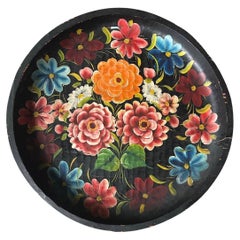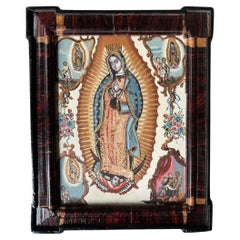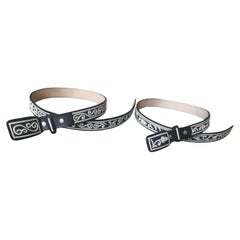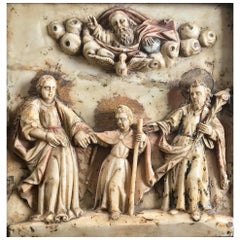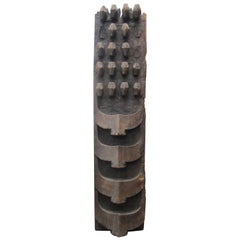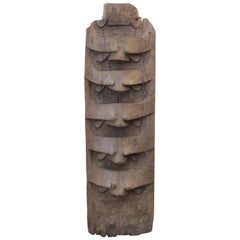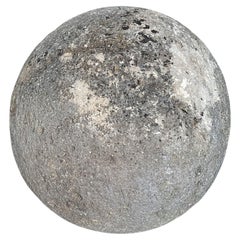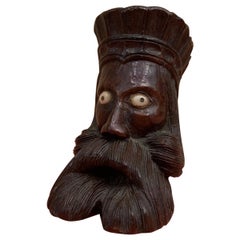Rodrigo Rivero Lake Folk Art
to
5
1
1
1
1
2
2
1
1
1
3
1
1
1
1
3
3
2
1
1
6
6
6
1
Batea michoacana pintada a mano
Located in Mexico City, MX
Esta exquisita batea michoacana es una pieza única de arte popular mexicano, hecha a mano por artesanos del estado de Michoacán. Tallada en una sola pieza de madera, su superficie có...
Category
Vintage 1950s Mexican Sculptures and Carvings
Materials
Wood
N.S de Guadalupe
By Popular Style
Located in Mexico City, MX
N. S de Guadalupe
Patron and Virgin of Mexico
Original Oil painting on Copper
Wooden frame, Charles IV style Puebla
J. Lecuona. 20Th Century
Guadalupe, mother Virgin of all ...
Category
20th Century Mexican Folk Art Paintings
Materials
Copper
$1,250
Traditional “Pita” Belt and Buckle
Located in Mexico City, MX
Traditional “Pita” Belt and Buckle
Pita comes from the fiber of the big maguey
Or large Mexican cactus and is hand inlaid
With Mexican charro designe. The remaining
Leather is ha...
Category
2010s Mexican Arts and Crafts Outsider and Self Taught Art
Materials
Leather
17th Century, Peruvian Huamanga Stone
Located in Mexico City, MX
It is a beautiful carved stone known as Huamanga stone, endemic of the Zone of Ayacucho, Viceroyalty of Peru. With a refined regional touch and loaded of pre-Columbian flavor as Chinese, It represents the Holy Family of Mary, Joseph and Jesus with God Father...
Category
Antique 17th Century Peruvian Sculptures and Carvings
Materials
Stone
Naga TOTEM, North-East India, 19th Century
Located in Mexico City, MX
Coming from the area of influence of the Naga people, this stunning monolitic piece is an extraordinary example of their cultural views. The Nagas are a conglomeration of different t...
Category
Antique 19th Century Southeast Asian Tribal Sculptures and Carvings
Materials
Wood
Naga TOTEM, North-East India, 19th Century
Located in Mexico City, MX
Coming from the area of influence of the Naga people, this stunning piece is an extraordinary example of their cultural views. The Nagas are a conglomeration of different tribes nati...
Category
Antique 19th Century Indian Tribal Art
Materials
Wood
Related Items
Large 19th Century Stone Sphere
Located in Vosselaar, BE
Stone spheres as these where made from antiquity to the present day. As a universal form it served as a ornamental object in gardens, architecture and interiors but also had a deeper...
Category
Antique Mid-19th Century French Sculptures and Carvings
Materials
Stone
19th Century Pipe Head
Located in Vosselaar, BE
You just got to love this guy! A wacky looking bearded Indian pipe head. Probably 19th century France. Beautifully carved by a artisan with a sense of humor.
Category
Antique Late 19th Century French Victorian Sculptures and Carvings
Materials
Wood
Folk Art Primitive Hand-Carved Bull
Located in Los Angeles, CA
Primitive hand-carved Folk Art bull made of wood. Great hand work and scale. One Horn has a chip. Great sculptural piece.
Category
Vintage 1970s American Sculptures and Carvings
Materials
Wood
Pair of Early 19th Century Carved Court Jesters Figural Carvings
Located in Godshill, Isle of Wight
A very fine pair of early 19th century carved figures, of Court Jesters
These bearded gentlemen have been superbly carved in the finest detail, they original came from a piece of ea...
Category
Antique Early 19th Century English Country Figurative Sculptures
Materials
Walnut
Mexican Folk Art Wood Carving Traditional Dance Handmade Alebrije One of a Kind
By Ruby Fabian, Manuel Cruz Prudencio
Located in Queretaro, Queretaro
The young dancers wear an armor of threads over their bodies, showing off an ancient indigenous art form. Colorful thread combinations characterize the huipil dress, a rectangle of cloth handwoven on a backstrap loom that dates back thousands of years in used in Zapotec culture. Through symbols in their dresses, Zapotec women wear their identity, history, culture, power, social and marital status, religion, personality, and power.
In this folkloric dance, “Flor de Piña” (Pineapple Flower), innocence surrounds young girls as they dance and hold pineapples on their shoulders as an offering. Their long braids represent purity and their bare feet symbolize their connection to the Earth.
This folkloric dance is part of the “Guelaguetza” (name in the indigenous Zapotec language) Festival Celebration. Since pre-hispanic times, the indigenous people of Oaxaca have honored the goddess of maize with this festival, performing and offering gifts to ensure a good harvest.
Husband and wife, master woodcarver Manuel Cruz and wood painter...
Category
21st Century and Contemporary Mexican Folk Art Sculptures and Carvings
Materials
Acrylic, Wood
$3,200
H 14.97 in W 14.97 in D 6.3 in
17th Century Primitive Religious Carving Oak Panel 1631
Located in Godshill, Isle of Wight
Primitive religious carving oak panel 1631
This rare piece comes from France, the somewhat Primitive carving shows the Madonna and Child sitting on the Devil who is depicted as a li...
Category
Antique 17th Century Medieval Sculptures and Carvings
Materials
Oak
Memento Mori in Wood with Chrismon, Monogram of Christ, Italy End of 17th Cent
Located in Milan, IT
A Memento Mori in wood with Chrismon, monogram of Christ. Valuable sculpture in fruit wood in almost true-to-life measurements, sculpted with art and finished with a wealth of details. The wood was covered with a thin layer of pellet and finished in color.
Immediately above the forehead, in correspondence with the anterior neonatal fontanel, the CHRISMON is painted in purple red. The monogram of Christ or Chi Rho (or CHRISMON) is a combination of letters from the Greek alphabet, which form an abbreviation of the name of Christ. Solar in nature, often inscribed in a circle with multiple rays reminiscent of the cosmic wheel deriving from the ancient solar emblems of Egypt. The symbol consists of two large overlapping letters, the 'X' and the 'P'. They correspond, respectively, to the Greek letter '?' ('chi', which reads kh, aspirated) and '?' ('rho', which reads r). These two letters are the initials of the word '???st??' (Khristòs ), the name of Jesus, which in Greek means "anointed" and translates the Hebrew "messiah". On the sides of these two letters, there are very often two others: one 'a' and one '?', alpha and omega...
Category
Antique Late 17th Century Italian Figurative Sculptures
Materials
Wood
$4,160
H 5.5 in W 5.5 in D 7 in
African Currency, 19th Century
Located in Dallas, TX
This set of 3 pieces of African currency is very interesting. Looking like some sort of ancient maraca, these 19th century pieces jingle and noise-make with each step. The dimensions...
Category
Antique 19th Century African Tribal Art
Materials
Metal
Pair of Carved Japanese Carved 3D Dumb Waiters or Card Butler Greeters
Located in Godshill, Isle of Wight
Pair of carved Japanese carved 3D dumb waiters or card butler greeters.
A very unusual pair of 1920s dumb waiters, a Geisha and a Samurai, these 2 card butlers are hand carved, ...
Category
Early 20th Century Japonisme Sculptures and Carvings
American Folk Art Cowboy and Horse Whirligig
Located in Santa Monica, CA
Tall one of a kind cowboy and horse spinning whirligig American Folk Art piece. Most likely from a larger folk art environment. Sheet steel constructi...
Category
Vintage 1940s American Folk Art Outsider and Self Taught Art
Materials
Iron, Sheet Metal
19th Century Slate Animal Grave Markers Tomb Stones Taxidermy Curio
Located in Lowestoft, GB
A collection of slate animal grave markers, these appear to of all been from the same family/estate/property. Likely all working animals and much loved.
All initialed and dated to...
Category
Antique Early 19th Century English Sculptures and Carvings
Materials
Slate
$1,232 / set
H 25.99 in W 12.01 in D 1.38 in
Slender 19th Century High-Backed Ethiopian Chair
Located in London, GB
This late nineteenth-century chair, from the Gindabarat in the Oromia region of Ethiopia, has been finely carved from a single piece of dense, heavy wood. The circular, narrow-in-siz...
Category
Antique Late 19th Century Ethiopian Tribal Tribal Art
Materials
Wood
